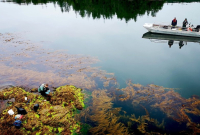Support strong Canadian climate journalism for 2025
I invite you to imagine the vast, ice-covered Arctic Ocean. The vision conjured — an icy and unforgiving seascape — is not one many would associate with noise akin to living next to a construction site. Yet, for much of our marine wildlife, this is becoming their reality. A reality my team and I aim to highlight in Ottawa at this week’s ArcticNet — an annual event bringing together Arctic and northern researchers from across Canada.
For many species, including seals, fish and whales that spend much of their year in the Arctic, sound, or the absence of it, is a lifeline. For decades, the natural soundscape of the Arctic Ocean has enabled these keystone species to thrive. However, thanks to a changing climate that makes shipping in the Arctic more accessible, and a growing global population consuming a greater quantity of goods, it is no longer soundless beneath the surface.
Enter Canada’s draft Ocean Noise Strategy — a long-awaited and much-needed framework that provides a focused effort by the federal government to understand, mitigate and manage underwater noise in Canada’s three oceans. The first iteration, a “discussion document,” appeared in 2021. But finalizing and implementing the strategy was a key commitment in Canada’s 2030 Nature Strategy released earlier this year.
While the latest draft strategy is welcome, particularly its multiple references to the Canadian Arctic, this draft of the noise strategy is ironically rather muted on measurable actions to curb noise.
Noise is an unseen pollutant that reverberates through ecosystems. This is particularly true in the oceans, where noise travels further and faster than in air. With ship traffic, drilling, seismic testing and other sources of human-caused noise steadily increasing in the ocean environment, we urgently need strategies to turn the noise down. The Arctic Ocean has, to date, not yet experienced the noise levels found in the Pacific and the Atlantic, thus presenting a golden opportunity to tackle these threats head on and proactively.
Nevertheless, the current strategy does not reflect this urgency. The government’s proposed approach feels tentative with no goals, only a few objectives, and actions presented as “recommendations.”
These recommendations lack any clear prioritization and bake in delays in favour of further research and future planning. At Wildlife Conservation Society (WCS) Canada, as scientists, we place incalculable value on a robust, conclusive evidence base. And there are certainly multiple important knowledge gaps that are yet to be addressed. But it is clear to those of us who work in the Canadian Arctic that the time to prioritize action is now.
For many key actions, like the establishment of national noise risk guidelines, we already have existing data. Furthermore, the first iteration of this strategy was published in 2021. After three and a half years, this latest draft still shows no clear commitment to implementation.
Delays are not the only concern.
The government’s proposals also severely lack specificity. Many recommendations are too vague to drive effective action. For example, instead of broadly calling for research on noise impacts, it should specify which species or knowledge gaps need urgent attention. Without much-needed clarity to direct the additional knowledge-gathering, the strategy suggests, we will be forever chasing our tails in pursuit of more information, while the cacophony under the waves continues to grow.
The strategy also fails to recognize that a singular approach to noise reduction will not work across all of Canada’s three oceans. Each ocean is home to a myriad of species, all with varying sensitivity to noise. Many of the species found in the Canadian Arctic, like beluga whales and narwhal, are among the most sensitive to underwater noise, requiring tailored thresholds and mitigation strategies.
The fact is, in its current form, Canada’s draft Ocean Noise Strategy lacks the urgency, clarity and specificity needed to protect the Arctic’s soundscape. The silent depths of the Arctic Ocean are not just a tangential feature of this fragile ecosystem — they are vital to the existence of its marine species. Without immediate, decisive action to turn down the volume, we risk fundamentally reshaping the future of some of the last strongholds on Earth for at-risk marine mammals.
This Arctic Science Month, Canada has the opportunity — and the responsibility — to lead the way in protecting the Arctic. Let’s ensure this strategy isn’t just a framework of vague, toothless recommendations, but a catalyst for real, measurable change.
The time to act is now.
Bill Halliday is a conservation scientist and the Arctic Acoustics lead in WCS Canada’s Western Arctic Program.






Comments